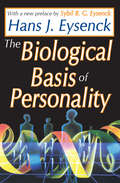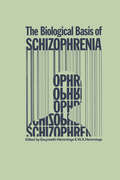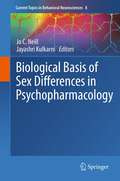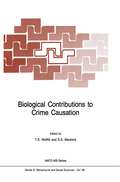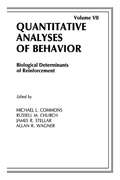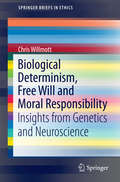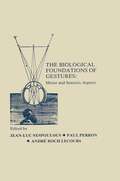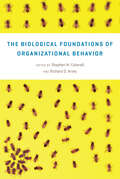- Table View
- List View
The Biological Basis of Personality
by Hans EysenckThis classic is one of the most cited and novel approaches to psychology ever written. Hans Eysenck presents a descriptive and causal model of human personality in accord with the major concepts of experimental psychology and the physiological and neurological mechanisms that form the biological basis of behavior patterns. His proposal for an alliance between personality and physiology represented a major innovation in the field of psychology, distinguished his research from his contemporaries, and set the stage for a wealth of research to come.Before this foundational work, Eysenck had initially constructed a model of personality in such works as Dimensions of Personality and The Experimental Study of Personality, but these were primarily descriptive in nature. A second phase of research included his Dynamics of Anxiety and Hysteria and Experiments with Drugs, where he provided causal analysis by reference to concepts then current in experimental psychology. The Biological Basis of Personality represents Eysenck's third phase, when he dug deeper to find biological causes underlying the psychological concepts of emotion, excitation, and inhibition--which had formed the building blocks of his earlier efforts. In this work, the causal links he postulates between personality variables and neurological and physiological discoveries establish a realistic model that takes theory out of the field of mere speculation.As Sybil Eysenck makes clear in her new preface, this book paved the way for a "marriage" of the experimental and individual difference approach in personality psychology.As Sybil Eysenck makes clear in her new preface, this book paved the way for a "marriage" of the experimental and individual difference approach in personality psychology.
The Biological Basis of Personality
by Hans EysenckThis classic is one of the most cited and novel approaches to psychology ever written. Hans Eysenck presents a descriptive and causal model of human personality in accord with the major concepts of experimental psychology and the physiological and neurological mechanisms that form the biological basis of behavior patterns. His proposal for an alliance between personality and physiology represented a major innovation in the field of psychology, distinguished his research from his contemporaries, and set the stage for a wealth of research to come.Before this foundational work, Eysenck had initially constructed a model of personality in such works as Dimensions of Personality and The Experimental Study of Personality, but these were primarily descriptive in nature. A second phase of research included his Dynamics of Anxiety and Hysteria and Experiments with Drugs, where he provided causal analysis by reference to concepts then current in experimental psychology. The Biological Basis of Personality represents Eysenck's third phase, when he dug deeper to find biological causes underlying the psychological concepts of emotion, excitation, and inhibition--which had formed the building blocks of his earlier efforts. In this work, the causal links he postulates between personality variables and neurological and physiological discoveries establish a realistic model that takes theory out of the field of mere speculation.As Sybil Eysenck makes clear in her new preface, this book paved the way for a "marriage" of the experimental and individual difference approach in personality psychology.As Sybil Eysenck makes clear in her new preface, this book paved the way for a "marriage" of the experimental and individual difference approach in personality psychology.
The Biological Basis of Schizophrenia
by Gwynneth Hemmings W. A. HemmingsFor years lip service has been paid to a belief in a biological basis for schizophrenia, but ,nevertheless psychosocial and psychodynamic "theories" of schizophrenia have been promulgated, and these have detracted from the all important biological work, Eclecticism has ruled the day and has caused considerable confusion, As a result research in schizophrenia has not progressed as fast as it should have done and treatment has been less effective than it could otherwise have been. This book is devoted to a wholly biological approach to the problem of schizophrenia, in the hope that many more workers will enter this exciting field of research. A wide variety of topics is covered, including brain structure; the genetics, pathogenesis and treatment of schizophrenia; a consideration of dietary and immunological factors and finally a chapter on alcoholism as it seems possible that the problems of schizophrenia and addiction are linked. We are grateful to all our contributors and to MTP Press for their enthusiasm for this book. Gwynneth P Hemmings William A Hemmings XI SECTION 1: Structure 1 The brain stem reticular formation K. E. WEBSTER There can be no question that the brain stem reticular lormation no longer exercises the same fascination for neurologists that it did a quarter of a century ago.
Biological Basis of Sex Differences in Psychopharmacology (Current Topics in Behavioral Neurosciences #8)
by Jo C. Neill and Jayashri KulkarniSex matters! Are there differences between the sexes when it comes to brain function and the behaviours that result? This volume attempts to answer this fundamental question. If the answer is ‘yes’ then this should impact upon our approach to treating mental illness in humans, and to modelling it in animals, as we look for aetiological and pharmacological solutions.
Biological Contributions to Crime Causation (NATO Science Series D: #40)
by T. E. Moffitt Sarnoff A. MednickThis book presents reviews of the literature and reports of new findings from research into biological correlates of criminal behavior. The chapters are revised versions of talks given by participants in an Advanced Study Institute sponsored by the North Atlantic Treaty Organization and held inCastelvecchio Pascoli in September, 1986. It is our second edited volume on biology and crime. The first book, The Causes of Cdme; New Biological Apwoaches, was published in 1987. In the preface to that book we described the regrettable hi. tory of the paeudobiological research into social problem. conducted by the Social Darwinists at the turn of the century. We requested that that unfortunate legacy not inhibit responsible and scientifically sound investigations of biological and psychological variables in criminology today. Evidence is mounting that showl that research limited to social and environmental vadables cannot explain the behavior of the minority of criminal offenders whose criminal careen begin in adolescence and develop into recidivistic and violent . . saults on society. Certainly these offenders are few, but epidemiological studies have found them to be responsible for an amount of crimes disproportionate to their small numbers. As few . . 5 % of males commit over 50% of criminal offenses. Intervention directed at these relatively few individuals could, if succes. ful, dramatically reduce our growing violent crime rate. The chapters in our earlier book showed that some biological variables do relate to this type of chronic offending.
Biological Determinants of Reinforcement: Biological Determinates of Reinforcement (Quantitative Analyses of Behavior Series)
by Michael L. Commons Russell M. Church James R. Stellar Allan R. WagnerThis seventh volume, divided into four parts, addresses the biological determinates of reinforcement and memory. Covers topics in electrical brain stimulation, drugs and reinforcement, and cellular mechanisms.
Biological Determinants of Reinforcement: Biological Determinates of Reinforcement (Quantitative Analyses of Behavior Series)
by Michael L. Commons, Russell M. Church, James R. Stellar and Allan R. WagnerThis seventh volume, divided into four parts, addresses the biological determinates of reinforcement and memory. Covers topics in electrical brain stimulation, drugs and reinforcement, and cellular mechanisms.
Biological Determinism, Free Will and Moral Responsibility: Insights from Genetics and Neuroscience (SpringerBriefs in Ethics)
by Chris WillmottThis book examines the way in which new discoveries about genetic and neuroscience are influencing our understanding of human behaviour. As scientists unravel more about the ways in which genes and the environment work together to shape the development of our brains, their studies have importance beyond the narrow confines of the laboratory. This emerging knowledge has implications for our notions of morality and criminal responsibility. The extent to which “biological determinism” can be used as an explanation for our behaviour is of interest to philosophers reflecting on the free will versus determinism debate. It also has repercussions for the criminal justice system; in courtrooms around the world, defence lawyers are beginning to appeal to genetic and brain imaging data as grounds for finding their clients not guilty. Can a defendant’s genes or the structure of his brain be used as an excuse for his behaviour? Is criminality “hardwired”? Is it legitimate to claim “I couldn’t help it, my genes made me do it”? This book appeals to anyone interested in the link between behaviour and genetics, the science and philosophy of moral responsibility and/or criminal law.
Biological Foundations of Emotion
by Robert Plutchik Henry KellermanBiological Foundations of Emotion is a detailed account of the relations between brain structure, functions, and emotions based on the results of experimental work and theoretical modeling. A range of issues are examined, such as whether there are structures, circuits, or biochemical events in the brain that control emotional expressions or experience; the effects of lesions and electrical stimulation on emotions; and the role of genetics in the expression of emotion. Comprised of 16 chapters, this volume begins with a presentation of general models of brain functioning. The first chapter deals with the neural substrate for emotion and cites evidence showing that the conventional concept of a limbic system underlying all emotions is not adequate. The discussion then turns to ethological and evolutionary factors of emotion, with emphasis on neuroendocrine patterns of emotional response; ictal symptoms relating to the nature of affects and their cerebral substrate; the anatomy of emotions; and neural systems involved in emotion in primates. Subsequent chapters present different but overlapping brain models of aggression and examine the role of biochemistry in understanding emotions. This book will be of interest to biologists and psychologists.
The Biological Foundations of Gesture: Motor and Semiotic Aspects (Neuropsychology and Neurolinguistics Series)
by Jean-Luc Nespoulous, Paul Perron and André Roch LecoursFirst published in 1986. Routledge is an imprint of Taylor & Francis, an informa company.
The Biological Foundations of Gesture: Motor and Semiotic Aspects (Neuropsychology and Neurolinguistics Series)
by J. L. Nespoulous P. Perron A. R. LecoursFirst published in 1986. Routledge is an imprint of Taylor & Francis, an informa company.
The Biological Foundations of Organizational Behavior
by Stephen M. Colarelli Richard D. ArveyIn recent years, evolutionary psychology and behavioral genetics have emerged as prominent theoretical perspectives within the social sciences. Yet despite broad levels of commonality between the disciplines—including an emphasis on adaptation, evolved mechanisms that guide behavior, and consequences of mismatch between these mechanisms and novel environments—studies that apply these perspectives on social behavior to organizations remain relatively rare. The Biological Foundations of Organizational Behavior brings together contributors who shed light on the potential that behavioral genetics and evolutionary psychology offer for studies of organizational behavior. In addition to examining the extant literature integrating these disciplines and organizational behavior, the book reconsiders a wide range of topics through the lens of biology within organizational behavior, including decision making, leadership and hierarchy, goals and collective action, and individual difference. Contributions also explore new areas of potential application and provide a critical assessment of the challenges that lie ahead. With accessible insights for scholars and practitioners, The Biological Foundations of Organizational Behavior marks a promising step forward in what is increasingly perceived to be an underdeveloped area of organizational behavior.
The Biological Foundations of Organizational Behavior
by Stephen M. Colarelli Richard D. ArveyIn recent years, evolutionary psychology and behavioral genetics have emerged as prominent theoretical perspectives within the social sciences. Yet despite broad levels of commonality between the disciplines—including an emphasis on adaptation, evolved mechanisms that guide behavior, and consequences of mismatch between these mechanisms and novel environments—studies that apply these perspectives on social behavior to organizations remain relatively rare. The Biological Foundations of Organizational Behavior brings together contributors who shed light on the potential that behavioral genetics and evolutionary psychology offer for studies of organizational behavior. In addition to examining the extant literature integrating these disciplines and organizational behavior, the book reconsiders a wide range of topics through the lens of biology within organizational behavior, including decision making, leadership and hierarchy, goals and collective action, and individual difference. Contributions also explore new areas of potential application and provide a critical assessment of the challenges that lie ahead. With accessible insights for scholars and practitioners, The Biological Foundations of Organizational Behavior marks a promising step forward in what is increasingly perceived to be an underdeveloped area of organizational behavior.
The Biological Foundations of Organizational Behavior
by Stephen M. Colarelli and Richard D. ArveyIn recent years, evolutionary psychology and behavioral genetics have emerged as prominent theoretical perspectives within the social sciences. Yet despite broad levels of commonality between the disciplines—including an emphasis on adaptation, evolved mechanisms that guide behavior, and consequences of mismatch between these mechanisms and novel environments—studies that apply these perspectives on social behavior to organizations remain relatively rare. The Biological Foundations of Organizational Behavior brings together contributors who shed light on the potential that behavioral genetics and evolutionary psychology offer for studies of organizational behavior. In addition to examining the extant literature integrating these disciplines and organizational behavior, the book reconsiders a wide range of topics through the lens of biology within organizational behavior, including decision making, leadership and hierarchy, goals and collective action, and individual difference. Contributions also explore new areas of potential application and provide a critical assessment of the challenges that lie ahead. With accessible insights for scholars and practitioners, The Biological Foundations of Organizational Behavior marks a promising step forward in what is increasingly perceived to be an underdeveloped area of organizational behavior.
The Biological Foundations of Organizational Behavior
by Stephen M. Colarelli and Richard D. ArveyIn recent years, evolutionary psychology and behavioral genetics have emerged as prominent theoretical perspectives within the social sciences. Yet despite broad levels of commonality between the disciplines—including an emphasis on adaptation, evolved mechanisms that guide behavior, and consequences of mismatch between these mechanisms and novel environments—studies that apply these perspectives on social behavior to organizations remain relatively rare. The Biological Foundations of Organizational Behavior brings together contributors who shed light on the potential that behavioral genetics and evolutionary psychology offer for studies of organizational behavior. In addition to examining the extant literature integrating these disciplines and organizational behavior, the book reconsiders a wide range of topics through the lens of biology within organizational behavior, including decision making, leadership and hierarchy, goals and collective action, and individual difference. Contributions also explore new areas of potential application and provide a critical assessment of the challenges that lie ahead. With accessible insights for scholars and practitioners, The Biological Foundations of Organizational Behavior marks a promising step forward in what is increasingly perceived to be an underdeveloped area of organizational behavior.
Biological Influences on Criminal Behavior
by Gail AndersonBiological Influences on Criminal Behavior, Second Edition is fully updated to include recent research, studies, and publications examining the integration of the biological view with mainstream social, psychological, and environmental views in influences in criminality and criminal behavior. The first edition of the book was written with the belief, grounded in research, that something vital can be discovered when we assess all the factors related to the causes of crime, including biology. Since the first edition published, it has become broadly accepted that biology is certainly a factor in criminal behavior, albeit a singular piece to the puzzle. Increased collaborations between scientists and criminologists has led to a much stronger understanding of the intricacies of biology’s role in behavior. As well, more criminologists have biological backgrounds. As the science involved became more complex, so too did this text. This second edition considers the more recent and integrated research that is being conducted today to show the interaction between the environment and a person’s biology that lead to our behavior. It has even been shown that the environment acts on, and actually changes the functions, of some genes. The book begins with basic scientific principles and advances to introduce the reader to the more in-depth discussions of various biological influencers. Biological Influences on Criminal Behavior, Second Edition is written primarily for social science and law students who wish to understand this exciting area. The book offers a greater understanding of this rapidly growing field so that its lessons can help to inform policy, treatments, rehabilitation and the law.
Biological Influences on Criminal Behavior
by Gail AndersonBiological Influences on Criminal Behavior, Second Edition is fully updated to include recent research, studies, and publications examining the integration of the biological view with mainstream social, psychological, and environmental views in influences in criminality and criminal behavior. The first edition of the book was written with the belief, grounded in research, that something vital can be discovered when we assess all the factors related to the causes of crime, including biology. Since the first edition published, it has become broadly accepted that biology is certainly a factor in criminal behavior, albeit a singular piece to the puzzle. Increased collaborations between scientists and criminologists has led to a much stronger understanding of the intricacies of biology’s role in behavior. As well, more criminologists have biological backgrounds. As the science involved became more complex, so too did this text. This second edition considers the more recent and integrated research that is being conducted today to show the interaction between the environment and a person’s biology that lead to our behavior. It has even been shown that the environment acts on, and actually changes the functions, of some genes. The book begins with basic scientific principles and advances to introduce the reader to the more in-depth discussions of various biological influencers. Biological Influences on Criminal Behavior, Second Edition is written primarily for social science and law students who wish to understand this exciting area. The book offers a greater understanding of this rapidly growing field so that its lessons can help to inform policy, treatments, rehabilitation and the law.
The Biological Mind: How Brain, Body, and Environment Collaborate to Make Us Who We Are
by Alan JasanoffA pioneering neuroscientist argues that we are more than our brains To many, the brain is the seat of personal identity and autonomy. But the way we talk about the brain is often rooted more in mystical conceptions of the soul than in scientific fact. This blinds us to the physical realities of mental function. We ignore bodily influences on our psychology, from chemicals in the blood to bacteria in the gut, and overlook the ways that the environment affects our behavior, via factors varying from subconscious sights and sounds to the weather. As a result, we alternately overestimate our capacity for free will or equate brains to inorganic machines like computers. But a brain is neither a soul nor an electrical network: it is a bodily organ, and it cannot be separated from its surroundings. Our selves aren't just inside our heads -- they're spread throughout our bodies and beyond. Only once we come to terms with this can we grasp the true nature of our humanity.
Biological Naturalism and the Mind-Body Problem
by Jane AndersonThis book offers a new theoretical framework within which to understand “the mind-body problem”. The crux of this problem is phenomenal experience, which Thomas Nagel famously described as “what it is like” to be a certain living creature. David Chalmers refers to the problem of “what-it-is-like” as “the hard problem” of consciousness and claims that this problem is so “hard” that investigators have either just ignored the issue completely, investigated a similar (but distinct) problem, or claimed that there is literally nothing to investigate – that phenomenal experience is illusory. This book contends that phenomenal experience is both very real and very important. Two specific “biological naturalist” views are considered in depth. One of these two views, in particular, seems to be free from problems; adopting something along the lines of this view might finally allow us to make sense of the mind-body problem.An essential read for anyone who believes that no satisfactory solution to “the mind-body problem” has yet been discovered.
Biological Psychiatry (Principles of Medical Biology #Volume 14)
by Edward BittarIt is now widely recognised that biological psychiatry is rapidly coming into its own. For over the last three decades dramatic advances in this young discipline have been made, all of which attest to the staying power of the experimental method. Those who made this revolution in knowledge happen are a breed of investigators availing themselves of the tools of molecular biology, pharmacology, genetics, and perhaps, above all, the technology of neuroimaging. The introduction of the interdisciplinary method of approach to the study of psychopathology had made it very clear that neuroimaging, as a set of techniques, is unique in that it is gradually providing us with evidence supporting Kraepelin's original view that mental illness is closely associated with abnormal changes in the brain.Broadly speaking, there are presently two structural techniques in neuroimaging - computed tomography and magnetic resonance imaging (MRI) - and three functional techniques - single photon emission tomography (SPECT), positron emission tomography and magnetic resonance imaging (fMRI). Through PET technology, for example, we have learned that, in early brain development, the primitive areas, mostly the brain stem and thalamus, are the first to show high activity in an infant. This is followed by the development of cortical areas by year one. Between the ages of four to 10, the cortex is almost twice as active in the child as in the adult. This information alerts us to what might happen in the way of trauma in abused children, especially those under the age of three. Child abuse increases the risk of physical changes, not only in the stress systems, but also in brain development (Glaser and Weissman). In addition to the difficult problem of post-traumatic stress disorder (PTSD), we have to take into account the possibility of other types of mental illness as the consequences of child abuse. These include depression, eating disorders, and drug and alcohol problems.The combination of PET and fMRI represents a more remarkable example of the power of neuroimaging since the two have made it feasible to map accurately in vitro identifiable cortical fields, or networks. In a landmark NIH investigation of human cortical reorganization (plasticity), persuasive evidence was brought forward showing that the process of learning as a motor task involves a specific network of neurons. These neurons occur in the cortical field that is responsible for that particular task. Such findings are important partly because they provide evidence supporting the current notion that labor in the cortex is divided among ensembles of specialized neurons that cooperate in the performance of complex tasks. Cooperation, then, in this, sense implies crosstalk among ensembles and that signals are both processed and retransmitted to neighbouring ensembles. To understand the workings of these ensembles, much better spatial and temporal resolution in functional brain mapping is required. This can be achieved with an NMR instrument whose magnet is 4.1 Tesla or more.
Biological Psychiatry
by Michael R. Trimble Mark GeorgeBiological psychiatry has dominated psychiatric thinking for the past 40 years, but the knowledge base of the discipline has increased substantially more recently, particularly with advances in genetics and neuroimaging. The third edition of Biological Psychiatry has been thoroughly updated taking into account these developments. As in the earlier editions of the book, there are comprehensive reviews and explanations of the latest advances in neurochemistry, neuroanatomy, genetics and brain imaging— descriptions not only of methodologies but also of the application of these in clinical settings. It is within this context that there is a considerable emphasis in the book on brain–behaviour relationships both within and without the clinical setting. This edition has been enhanced by the inclusion of new chapters, one on anxiety and another on motivation and the addictions. The chapter that relates to treatments has been extended to include the latest information on brain stimulation techniques. The overall book is well illustrated in order to help with an understanding of the text. For the third edition, Professor Michael Trimble has been joined by Professor Mark George as co-author. These are two of the world's leading biological psychiatrists who both have considerable clinical as well as research experience which they have brought to the book. Unlike multiauthored texts, it has a continuity running through it which aids understanding and prevents repetition. This book is strongly recommended for all practising psychiatrists and trainees wishing for an up-to-date, authoritative, easy to digest and acessible review of the latest advances and conceptualizations in the field. It will also appeal to neurologists interested in neuropsychiatry and biological psychiatry or the psychiatric aspects of neurological disorders, as well as other practising clinicians (psychologists, social workers, nurses) in the mental health field.
Biological Psychiatry
by Michael R. Trimble Mark GeorgeBiological psychiatry has dominated psychiatric thinking for the past 40 years, but the knowledge base of the discipline has increased substantially more recently, particularly with advances in genetics and neuroimaging. The third edition of Biological Psychiatry has been thoroughly updated taking into account these developments. As in the earlier editions of the book, there are comprehensive reviews and explanations of the latest advances in neurochemistry, neuroanatomy, genetics and brain imaging— descriptions not only of methodologies but also of the application of these in clinical settings. It is within this context that there is a considerable emphasis in the book on brain–behaviour relationships both within and without the clinical setting. This edition has been enhanced by the inclusion of new chapters, one on anxiety and another on motivation and the addictions. The chapter that relates to treatments has been extended to include the latest information on brain stimulation techniques. The overall book is well illustrated in order to help with an understanding of the text. For the third edition, Professor Michael Trimble has been joined by Professor Mark George as co-author. These are two of the world's leading biological psychiatrists who both have considerable clinical as well as research experience which they have brought to the book. Unlike multiauthored texts, it has a continuity running through it which aids understanding and prevents repetition. This book is strongly recommended for all practising psychiatrists and trainees wishing for an up-to-date, authoritative, easy to digest and acessible review of the latest advances and conceptualizations in the field. It will also appeal to neurologists interested in neuropsychiatry and biological psychiatry or the psychiatric aspects of neurological disorders, as well as other practising clinicians (psychologists, social workers, nurses) in the mental health field.
Biological Psychiatry, Higher Nervous Activity: Volume 1 and Volume 2
by P. PichotThe purpose of the World Psychiatric Association is to coordinate the activities of its Member Societies on a world-wide scale and to advance enquiry into the etiology, pathology, and treatment of mental illness. To further this purpose, the Association organizes mono- or multithematic Regional Symposia in different parts of the world twice a year, and World Congresses dealing with all individual fields of psychiatry once every five or six years. Between these meetings the continuation of the Association's scientific work is assured through the activities of its specialty sections, each covering an important field of psychiatry. The programs of the World Congresses reflect on the one hand the intention to present the coordinating functions of the Association and on the other to open a broad platform for a free exchange of views. Thus, the VII World Congress of Psychiatry, held in Vienna from July 11 to 16, 1983, was composed of two types of scientific events - those structured by the Association and those left to the initiative of the participants. The first type comprised Plenary Sessions, planned by the Scientific Program Committee, and Section Symposia, organized by the WPA sections; the second embraced Free Symposia, free papers, video sessions, and poster presentations prepared by the participants. Altogether, 10 Plenary Sessions, 52 Section Symposia, and 105 Free Symposia took place, and 78 free papers and poster sessions and 10 video sessions were held.
Biological Psychiatry of Cancer and Cancer Treatment
by Andrew HodgkissAs long-term cancer survival becomes a widely-shared experience, the quality of life of people living with and beyond a cancer diagnosis is increasingly important. Optimising the prevention and treatment of any psychiatric consequences of certain tumours and treatments is now central to high-quality cancer care. Biological Psychiatry of Cancer and Cancer Treatment provides the reader with expert guidance on how to prevent, detect and manage the 'organic' psychiatric disorders experienced by people with cancer. Containing 13 chapters on topics from 'Surgery and Radiotherapy', and 'Hormone and Cytokine treatments' to 'Clinical Psychiatric Assessment of Patients with Cancer' this unique resource offers readers with fully up-to-date and high-quality information on how to enhance the quality of life for patients living with, and beyond cancer. Offering a unique approach to oncology and psycho-oncology, Biological Psychiatry of Cancer and Cancer Treatment is an invaluable resource for academic psychiatrists, liaison psychiatrists, neuropsychiatrists, Oncologists, neuro-oncologists, palliative medicine doctors and drug development scientists.
Biological Psychiatry of Cancer and Cancer Treatment
by Andrew HodgkissAs long-term cancer survival becomes a widely-shared experience, the quality of life of people living with and beyond a cancer diagnosis is increasingly important. Optimising the prevention and treatment of any psychiatric consequences of certain tumours and treatments is now central to high-quality cancer care. Biological Psychiatry of Cancer and Cancer Treatment provides the reader with expert guidance on how to prevent, detect and manage the 'organic' psychiatric disorders experienced by people with cancer. Containing 13 chapters on topics from 'Surgery and Radiotherapy', and 'Hormone and Cytokine treatments' to 'Clinical Psychiatric Assessment of Patients with Cancer' this unique resource offers readers with fully up-to-date and high-quality information on how to enhance the quality of life for patients living with, and beyond cancer. Offering a unique approach to oncology and psycho-oncology, Biological Psychiatry of Cancer and Cancer Treatment is an invaluable resource for academic psychiatrists, liaison psychiatrists, neuropsychiatrists, Oncologists, neuro-oncologists, palliative medicine doctors and drug development scientists.
